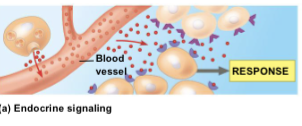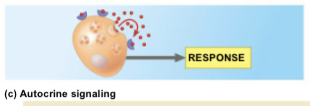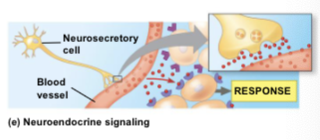Endocrine System Learning Outcomes (In Progress)
1/9
There's no tags or description
Looks like no tags are added yet.
Name | Mastery | Learn | Test | Matching | Spaced |
|---|
No study sessions yet.
10 Terms
Differentiate between paracrine, autocrine, endocrine, and neuroendocrine signaling when
described or illustrated

Endocrine (inside release)
release signal within blood vessels
carries signals through bloodstream to effector cells within effector organ

Paracrine (beside release)
release hormones that affect neighboring cells

Autocrine (self release)
Releasing something that a cell responds to itself (singular cell)

Synaptic
Neurons communicate directly with cells

Neuroendocrine
Between a neuro-secratory cell and the endocrine system itself (through blood vessels)
Compare two types of cellular responses to a hormonal signal: cytoplasmic response and genomic response (gene regulation)
Water-soluble hormones → bind to membrane receptors → cause rapid cytoplasmic responses (e.g., enzyme activation).
Lipid-soluble hormones → cross membranes → bind intracellular receptors → cause genomic responses (changes in gene expression).
Cytoplasmic responses:
A cellular response that occurs in the cytoplasm and involves changes in existing proteins or enzymes.
Hormone binding triggers a signaling cascade (e.g., second messengers like cAMP, Ca²⁺, or phosphorylation of proteins) that modifies the activity of pre-existing enzymes or other cytoplasmic components.
Genomic responses:
A response that involves changes in gene expression, leading to synthesis of new proteins.
Hormone or hormone–receptor complex enters the nucleus or activates transcription factors, which bind DNA to increase or decrease transcription of target genes.
State the solubility of peptide, steroid, and amine hormone types, and contrast the signaling
pathways of water soluble and insoluble hormones
Explain the consequences hormone solubility in water in terms of hormone function
State the functions of major mammalian hormones, and the tissues mainly responsible for
secreting each hormone: thyroid hormone, epinephrine, glucocorticoids (cortisol), estrogens,
progesterone, androgens (testosterone), melatonin, oxytocin, ADH, FSH, LH, ACTH, prolactin,
insulin, glucagon
Label the major tissues that secrete hormones on a diagram
Draw and label a basic positive and negative feedback loop for regulation of hormone levels,
explain the general biological processes regulated by such loops, and give an example of each
Describe and label a general hypothalamus-anterior pituitary-gland hormonal cascade
Explain the role of hormone receptors in regulating hormone functions, and how variation in
receptors and tissues can lead to different responses to the same hormone
Illustrate the function, significance, and control of the Hypothalamic-Pituitary-Adrenal (HPA)
axis.